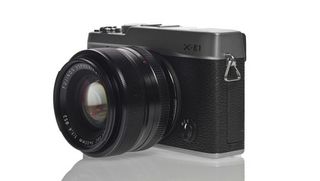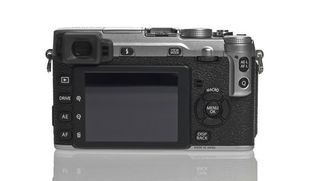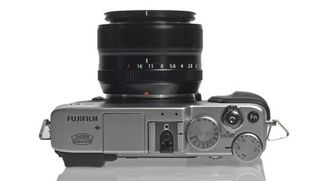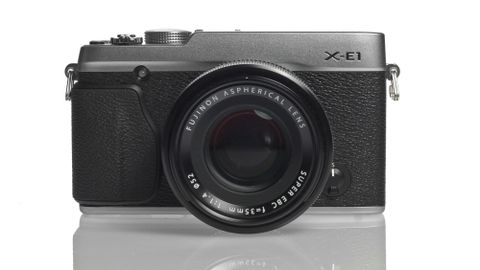TechRadar Verdict
Pros
- +
Improved autofocus
- +
Retro design
- +
Lots of dials
- +
Fantastic EVF
Cons
- -
Not a touchscreen
- -
Can't shoot raw in all situations
- -
Hidden video mode
Why you can trust TechRadar
Updated: Now with a page comparing the Fuji X-E1 with the Fuji X-Pro1.
In recent years, Fuji has enjoyed great success, especially critically, with its premium series of X cameras. The Fuji X-E1 is the second in the lineup to feature interchangeable lenses, and is an addition to, rather than a replacement for, the Fuji X-Pro1.
Technically, it sits below the Fuji X-Pro1, both in terms of specs and cost, and as such there are notable differences between the two.
Widely praised by both critics and the audience, the Fuji X-Pro1's sensor is comparable to some full-frame sensors in our lab tests, and the images it produces are fantastic.

It is this 16.1 million pixel APS-C X-Trans CMOS sensor that is also included in the Fuji X-E1.
There's always been one huge drawback for the consumer audience when it comes to the Fuji X-Pro1 - the price. It currently retails for around £1,200/AU$1,200/US$1,700, body only, with each of the three prime optics retailing for around £500/AU$650/US$600 each.
By comparison, the Fuji X-E1 can currently be bought, body only, for around £729/AU$1,198/US$999.

Or, for roughly the same price you pay for the Fuji X-Pro1 body only, you can pick up an Fuji X-E1 with the brand new 18-55mm f/2.8-4 kit lens. In short, this is the Fuji X-Pro1 for consumers.
Another big criticism of the Fuji X-Pro1 was its autofocusing speed, which could be pretty sluggish at times. Fuji was well aware of this issue, and has now issued a firmware upgrade for the Fuji X-Pro1, which should go a long way to solving that problem.
This version of the firmware is already included on the Fuji X-E1 as standard. Fuji claims that with the new 18-55mm lens, this enables focusing speeds of 0.1 seconds.

Along with the sensor, some of the other specs from the Fuji X-Pro1 are also shared with the Fuji X-E1. Because the image processor is also the same, image quality should be more or less identical.
Technology adapted from analogue film has been used to create the sensor, which features a unique colour filter arrangement to produce low-noise images even at high ISO settings.
Unlike the Fuji X-Pro1, though, the Fuji X-E1 doesn't use a hybrid optical and electronic viewfinder, instead relying on an electronic device only.

It does, however, have a higher resolution. Its 2.36 million dots makes it comparable with the Sony NEX-7, and one of the brightest EVFs currently on the market. Because it doesn't have the hybrid device, the overall body size is smaller.
Available in two colours, Fuji's designers say that the X-E1 has been designed with two different kinds of photographer in mind. The all-black version is thought to be appealing to discreet street shooters, while the silver and black version - with its retro style body - is designed with more image-conscious users in mind.
With its lower price, the Fujifilm X-E1 is a more direct competitor of the Sony NEX-7 and Olympus OM-D.
Amy has been writing about cameras, photography and associated tech since 2009. Amy was once part of the photography testing team for Future Publishing working across TechRadar, Digital Camera, PhotoPlus, N Photo and Photography Week. For her photography, she has won awards and has been exhibited. She often partakes in unusual projects - including one intense year where she used a different camera every single day. Amy is currently the Features Editor at Amateur Photographer magazine, and in her increasingly little spare time works across a number of high-profile publications including Wired, Stuff, Digital Camera World, Expert Reviews, and just a little off-tangent, PetsRadar.

Over a billion users could be at risk from keyboard logging app security flaw

Apple is reportedly developing its own AI servers — could it be gearing up to take on Nvidia and AMD?

This Game Boy-styled MagSafe stand just tickled my retro-gaming synapse – now all I need is a matching controller for Nintendo emulators

